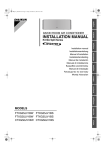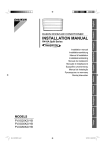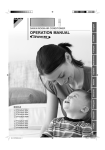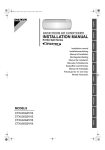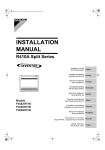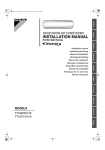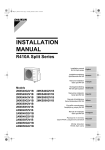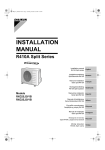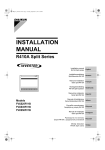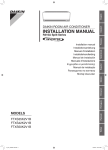Download Daikin FTXG50JV1BW Installation manual
Transcript
DAIKIN ROOM AIR CONDITIONER INSTALLATION MANUAL Deutsch English 00_CV_3P255640-2B.fm Page 1 Tuesday, December 28, 2010 7:19 PM Manual de instalação FTXG25JV1BW FTXG35JV1BW FTXG50JV1BW CTXG50JV1BW FTXG25JV1BS FTXG35JV1BS FTXG50JV1BS CTXG50JV1BS Nederlands Türkçe MODELS Рóссêий Portugues ΕλληνικÜ Español Italiano Installation manual Installationsanleitung Manuel d’installation Installatiehandleiding Manual de instalación Manuale di installazione Français R410A Split Series FTXG25JV1BW, FTXG25JV1BS, FTXG35JV1BW, FTXG35JV1BS, CTXG50JV1BW, CTXG50JV1BS, FTXG50JV1BW, FTXG50JV1BS DAIKIN INDUSTRIES, LTD. , , Shinri Sada Manager Quality Control Department Low Voltage 2006/95/EC Electromagnetic Compatibility 2004/108/EC * Umeda Center Bldg., 2-4-12, Nakazaki-Nishi, Kita-ku, Osaka, 530-8323 Japan 74736-KRQ/EMC97-4957 KEMA Quality B.V. DAIKIN.TCF.015 N9/01-2011 3SB64417-17P.fm Page 1 Friday, February 4, 2011 2:59 PM 3SB64417-17P FTXG25JV1BW, FTXG25JV1BS, FTXG35JV1BW, FTXG35JV1BS, CTXG50JV1BW, CTXG50JV1BS, FTXG50JV1BW, FTXG50JV1BS , , Shinri Sada Manager Quality Control Department Umeda Center Bldg., 2-4-12, Nakazaki-Nishi, Kita-ku, Osaka, 530-8323 Japan 3SB64417-18L.fm Page 1 Wednesday, February 16, 2011 10:57 AM 3SB64417-18L 3SB64417-18L.fm Page 2 Wednesday, February 16, 2011 10:57 AM 01_EN_3P255640-2B.fm Page 1 Wednesday, January 5, 2011 8:52 AM Safety Precautions • The precautions described herein are classified as WARNING and CAUTION. They both contain important information regarding safety. Be sure to observe all precautions without fail. • Meaning of WARNING and CAUTION notices WARNING .... Failure to follow these instructions properly may result in personal injury or loss of life. CAUTION ..... Failure to observe these instructions properly may result in property damage or personal injury, which may be serious depending on the circumstances. • The safety marks shown in this manual have the following meanings: Be sure to follow the instructions. Be sure to establish an earth connection. Never attempt. • After completing installation, conduct a trial operation to check for faults and explain to the customer how to operate the air conditioner and take care of it with the aid of the operation manual. WARNING • Ask your dealer or qualified personnel to carry out installation work. Do not attempt to install the air conditioner yourself. Improper installation may result in water leakage, electric shocks or fire. • Install the air conditioner in accordance with the instructions in this installation manual. Improper installation may result in water leakage, electric shocks or fire. • Be sure to use only the specified accessories and parts for installation work. Failure to use the specified parts may result in the unit falling, water leakage, electric shocks or fire. • Install the air conditioner on a foundation strong enough to withstand the weight of the unit. A foundation of insufficient strength may result in the equipment falling and causing injury. • Electrical work must be performed in accordance with relevant local and national regulations and with instructions in this installation manual. Be sure to use a dedicated power supply circuit only. Insufficiency of power circuit capacity and improper workmanship may result in electric shocks or fire. • Use a cable of suitable length. Do not use tapped wires or an extension lead, as this may cause overheating, electric shocks or fire. • Make sure that all wiring is secured, the specified wires are used, and that there is no strain on the terminal connections or wires. Improper connections or securing of wires may result in abnormal heat build-up or fire. • When wiring the power supply and connecting the wiring between the indoor and outdoor units, position the wires so that the control box lid can be securely fastened. Improper positioning of the control box lid may result in electric shocks, fire or over heating terminals. • If refrigerant gas leaks during installation, ventilate the area immediately. Toxic gas may be produced if the refrigerant comes into contact with fire. • After completing installation, check for refrigerant gas leakage. Toxic gas may be produced if the refrigerant gas leaks into the room and comes into contact with a source of fire, such as a fan heater, stove or cooker. • When installing or relocating the air conditioner, be sure to bleed the refrigerant circuit to ensure it is free of air, and use only the specified refrigerant (R410A). The presence of air or other foreign matter in the refrigerant circuit causes abnormal pressure rise, which may result in equipment damage and even injury. • During installation, attach the refrigerant piping securely before running the compressor. If the refrigerant pipes are not attached and the stop valve is open when the compressor is run, air will be sucked in, causing abnormal pressure in the refrigeration cycle, which may result in equipment damage and even injury. • During pump-down, stop the compressor before removing the refrigerant piping. If the compressor is still running and the stop valve is open during pump-down, air will be sucked in when the refrigerant piping is removed, causing abnormal pressure in the refrigeration cycle, which may result in equipment damage and even injury. • Be sure to earth the air conditioner. Do not earth the unit to a utility pipe, lightning conductor or telephone earth lead. Imperfect earthing may result in electric shocks. • Be sure to install an earth leakage breaker. Failure to install an earth leakage breaker may result in electric shocks or fire. CAUTION • Do not install the air conditioner at any place where there is a danger of flammable gas leakage. In the event of a gas leakage, build-up of gas near the air conditioner may cause a fire to break out. • While following the instructions in this installation manual, install drain piping to ensure proper drainage and insulate piping to prevent condensation. Improper drain piping may result in indoor water leakage and property damage. • Tighten the flare nut according to the specified method such as with a torque wrench. If the flare nut is too tight, it may crack after prolonged use, causing refrigerant leakage. 1 ■English 01_EN_3P255640-2B.fm Page 2 Wednesday, January 5, 2011 8:52 AM Indoor unit English Accessories A – J , A Mounting plate D Remote controller holder 1 1 G Operation manual 1 B Titanium apatite photocatalytic air-purifying filter H Installation manual E Dry battery AAA. LR03 (alkaline) 2 2 J Paper pattern C Wireless remote controller (The paper pattern is placed between the last page and the inner side of the back cover. See page 10 for the usage of the paper pattern.) F Indoor unit fixing screw (M4 × 12L) 1 1 2 Left-bottom Right-bottom Service Parts • Obtain service parts as necessary. • If a service part is required, obtain and install the part indicated by the part number corresponding to the unit’s model name. K Side cover for right-side piping Model name FTXG25JV1BW FTXG35JV1BW FTXG50JV1BW CTXG50JV1BW Part name Model name 5003651 FTXG25JV1BS FTXG35JV1BS FTXG50JV1BS CTXG50JV1BS L Side cover for left-side piping Part name Model name 5003653 FTXG25JV1BW FTXG35JV1BW FTXG50JV1BW CTXG50JV1BW Part name Model name Part name 5003652 FTXG25JV1BS FTXG35JV1BS FTXG50JV1BS CTXG50JV1BS 5003654 CAUTION • K Side cover for right-side piping is labeled with information concerning applicable safety standards. When replacing the right-side cover with K side cover for right-side piping, install the cover securely without removing this labeling. Choosing an Installation Site • Before choosing the installation site, obtain user approval. 1. Indoor unit • The indoor unit should be sited in a place where: 1) the restrictions on installation specified in the indoor unit installation drawings are met, 2) both air inlet and air outlet have clear paths met, 3) the unit is not in the path of direct sunlight, 4) the unit is away from the source of heat or steam, 5) there is no source of machine oil vapour (this may shorten indoor unit life), 6) cool (warm) air is circulated throughout the room, 7) the unit is away from electronic ignition type fluorescent lamps (inverter or rapid start type) as they may shorten the remote controller range, 8) the unit is at least 1m away from any television or radio set (unit may cause interference with the picture or sound), 9) install at the recommended height (1.8m), 10) no laundry equipment is located. 2. Wireless remote controller • Turn on all the fluorescent lamps in the room, if any, and find the site where remote controller signals are properly received by the indoor unit (within 6m). ■English 2 01_EN_3P255640-2B.fm Page 3 Wednesday, January 5, 2011 8:52 AM Indoor Unit Installation Drawings n How to attach the indoor unit A Mounting plate A Mounting plate Hook the claws of the bottom frame to the mounting plate. If the claws are difficult to hook, remove the front grille. Clip Front grille The mounting plate should be installed on a wall which can support the weight of the indoor unit. Screws (field supply: M4 × 25L) Bottom frame Front panel Screws (M4 × 16L) * When dismounting the front grille, refer to removing and installing front grille on page 4. 100mm or more from ceiling INTELLIGENT EYE sensor Caulk pipe hole gap with putty. 50mm or more from walls (on both sides) Air filters 500mm or more Make sure that there are no obstacles within 500mm under the signal receiver. Such obstacles, if any, may have an adverse influence on the reception performance of the receiver and the reception distance may be shortened. B Titanium apatite photocatalytic air-purifying filter (2) Filter frame Claw Titanium apatite photocatalytic air-purifying filter Service lid n Opening service lid Cut thermal insulation pipe to an appropriate length and wrap it with tape, making sure that no gap is left in the insulation pipe’s cut line. Wrap the insulation pipe with the finishing tape from bottom to top. C Wireless remote controller Service lid is opening/closing type. n Opening method 1) Remove the service lid screws. 2) Pull out the service lid diagonally down in the direction of the arrow. 3) Pull down. Before screwing the remote controller holder to the wall, make sure that control signals are properly received by indoor unit. Tab Air filter D Remote controller holder Fixing screws for remote controller holder (field supply: M3 × 20L) INTELLIGENT EYE sensor CAUTION • Do not hit or violently push the INTELLIGENT EYE sensor. This can lead to damage and malfunction. • Do not place large objects near the sensor. Also keep heating units or humidifiers outside the sensor’s detection area. 3 ■English 01_EN_3P255640-2B.fm Page 4 Wednesday, January 5, 2011 8:52 AM 1. English Preparation before Installation Removing and installing front panel • Removal method 1) Hook fingers on the indentations on the left and right sides of the indoor unit, and open the front panel to a position higher than the horizontal level. 2) Raise the front panel lock tabs on the left and right sides, and slide the front panel locks upward. 3) Remove the panel shafts on both sides from the shaft holes, and dismount the front panel. • Installation method 1) Insert the panel shafts on both sides of the front panel into the shaft holes. 2) Slide the front panel locks downward, and secure the front panel locks with the tabs laid outward. 3) Close the front panel after checking that the front panel is securely mounted. (a) Removal method 1) Pull Front panel shaft 2) Slide (a) (b) 4) Pull 3) Slide Front panel locks (b) Installation method Front panel shaft 2) Push 1) Slide Open at least 90 degrees. * Front panel locks Slot * The front panel will not close completely if the front panel locks have not been properly engaged. 2. Removing and installing front grille • Removal method 1) Remove the front panel and air filters. 2) Remove the service lid. (Refer to the opening method on page 3.) 3) Disconnect the wire harness from the wire clamp, and remove the wire harness from the connector. 4) Remove the right-side cover. (2 screws) Screws Wire clamp Connector Wire harness Lift up on the cover and open it toward the outside. Right-side cover 5) Rotate the flap (large) and dismount the flap (small). 6) Open the 2 screw covers, and remove 4 screws from the front grille. • Opening method 4 points Upward Screw driver Frap (small) ■English 4 01_EN_3P255640-2B.fm Page 5 Wednesday, January 5, 2011 8:52 AM Preparation before Installation 7) Wear protection gloves and insert both hands under the front grille as shown in the illustration. 8) Remove the front grille from the 3 upper hooks by pushing up the top side of the front grille, pull the front grille toward you by holding both ends of the front grille, and dismount the front grille. 1) Push up. Upper hooks 2) Pull toward you. CAUTION • Be sure to wear protection gloves. • Installation method 1) 2) 3) 4) 5) Install the front grille and firmly engage the upper hooks (3 locations). Install 4 screws of the front grille, and close the 2 screw covers. Mount the flap (small) and return the flaps to the previous positions. Attach the right-side cover. (Refer to figure.) Attach the wire harness to the connector and secure the wire harness with the wire clamp. 6) Install the air filter and then mount the front panel. How to set the different addresses [Indoor unit] [Remote controller] INTELLIGENT EYE sensor Jumper JA When two indoor units are installed in one room, the two wireless remote controllers can be set for different addresses. 1) Remove the front panel and front grille. (4 screws) 2) Cut the address jumper (JA) on the printed circuit board. 3) Cut the address jumper in the remote controller. ADDRESS : JA EXIST : 1 CUT : 2 3. <Bottom of electrical wiring box> 4. ADDRESS EXIST 1 CUT 2 When connecting to an HA system (wired remote controller, central remote controller etc.) • Removal methods of metal plate electrical wiring covers 1) Remove the front panel and front grille. (4 screws) 2) Remove the electrical wiring box. (1 screw) 3) Remove the 4 tabs and dismount the metal plate electrical wiring cover (A). 4) Pull down the hook on the metal plate electrical wiring cover (B), and remove a single tab. 5) Remove the 2 tabs on the top part and dismount the metal plate electrical wiring cover (B). Metal plate electrical wiring cover (A) Metal plate electrical wiring cover (B) [From back side] Screw Single tab Pull down 5 ■English • Attachment methods of connection cord English 01_EN_3P255640-2B.fm Page 6 Wednesday, January 5, 2011 8:52 AM HA connector (S21) 1) Remove the metal plate electrical wiring cover. (Refer to the Removal methods of metal plate electrical wiring covers.) 2) Attach the connection cord to the S21 connector and pull the harness out through the notched part in the figure. 3) Replace the electrical wiring cover as it was, and pull the harness around, as shown in the figure. Screw • Attachment methods of metal plate electrical wiring covers Metal plate electrical wiring cover (B) 1) Hook the top part of the metal plate electrical wiring cover (B) on the 2 tabs. 2) Press in the hook on the bottom to catch a single tab, and mount the metal plate electrical wiring cover (B). 3) Insert the connector into the hole, and hook and mount the metal plate electrical wiring cover (A) onto the 4 tabs. Metal plate electrical wiring cover (A) Refrigerant Piping Work With a multi indoor unit , install as described in the installation manual supplied with the multi outdoor unit. 1. Flaring the pipe end 1) Cut the pipe end with a pipe cutter. 2) Remove burrs with the cut surface facing downward so that the chips do not enter the pipe. 3) Put the flare nut on the pipe. 4) Flare the pipe. 5) Check that the flaring is properly made. (Cut exactly at right angles.) Remove burrs. Flaring Set exactly at the position shown below. Flare tool for R410A A Die A Conventional flare tool Clutch-type Clutch-type (Rigid-type) Wing-nut type (Imperial-type) 0-0.5mm 1.0-1.5mm 1.5-2.0mm Check Flare’s inner surface must be flaw-free. The pipe end must be evenly flared in a perfect circle. Make sure that the flare nut is fitted. WARNING • Do not use mineral oil on flared part. • Prevent mineral oil from getting into the system as this would reduce the lifetime of the units. • Never use piping which has been used for previous installations. Only use parts which are delivered with the unit. • Do never install a drier to this R410A unit in order to guarantee its lifetime. • The drying material may dissolve and damage the system. • Incomplete flaring may cause refrigerant gas leakage. ■English 6 01_EN_3P255640-2B.fm Page 7 Wednesday, January 5, 2011 8:52 AM Refrigerant Piping Work 2. Refrigerant piping CAUTION • Use the flare nut fixed to the main unit. (To prevent cracking of the flare nut by aged deterioration.) • To prevent gas leakage, apply refrigeration oil only to the inner surface of the flare. (Use refrigeration oil for R410A.) • Use torque wrenches when tightening the flare nuts to prevent damage to the flare nuts and gas leakage. Align the centres of both flares and tighten the flare nuts 3 or 4 turns by hand. Then tighten them fully with the torque wrenches. [Apply oil] [Tighten] Apply refrigeration oil to the inner surface of the flare. Do not apply refrigeration oil to the outer surface. Torque wrench Flare nut Spanner Piping union Do not apply refrigeration oil to the flare nut avoid tightening with over torque. Flare nut Flare nut tightening torque Gas side Liquid side 3/8 inch 1/2 inch 1/4 inch 32.7-39.9N•m (330-407kgf•cm) 49.5-60.3N•m (505-615kgf•cm) 14.2-17.2N•m (144-175kgf•cm) 2-1. Caution on piping handling 1) Protect the open end of the pipe against dust and moisture. 2) All pipe bends should be as gentle as possible. Use a pipe bender for bending. Be sure to place a cap. Rain Wall If no flare cap is available, cover the flare mouth with tape to keep dirt or water out. 2-2. Selection of copper and heat insulation materials • When using commercial copper pipes and fittings, observe the following: 1) Insulation material: Polyethylene foam Heat transfer rate: 0.041 to 0.052W/mK (0.035 to 0.045kcal/mh°C) Refrigerant gas pipe’s surface temperature reaches 110°C max. Choose heat insulation materials that will withstand this temperature. Inter-unit wire Gas pipe Gas pipe insulation 2) Be sure to insulate both the gas and liquid piping and to provide insulation dimensions as below. Gas side Liquid side 25/35 class 50 class O.D. 9.5mm O.D. 12.7mm O.D. 6.4mm Gas pipe thermal insulation 25/35 class 50 class I.D. 12-15mm I.D. 14-16mm Minimum bend radius 30mm or more 40mm or more Finishing tape Liquid pipe Liquid pipe insulation Drain hose Liquid pipe thermal insulation I.D. 8-10mm Thickness 10mm Min. 30mm or more Thickness 0.8mm (C1220T-O) 3) Use separate thermal insulation pipes for gas and liquid refrigerant pipes. 7 ■English 01_EN_3P255640-2B.fm Page 8 Wednesday, January 5, 2011 8:52 AM 1. English Indoor Unit Installation Installing the mounting plate • The mounting plate should be installed on a wall which can support the weight of the indoor unit. 1) Temporarily secure the mounting plate to the wall, make sure that the unit is completely level, and mark the boring points on the wall. 2) Secure the mounting plate to the wall with screws. Recommended mounting plate retention spots and dimensions Recommended mounting plate retention spots (7 spots in all) 260 200 (Bolt size: M10) (Bolt size: M10) 100 φ65 47 47 φ65 Drain hose position 105 Use tape measure as shown. Position the end of tape measure at ∇. 295 62 Place a leveler on raised tab. 100 Gas pipe end 135 302 160 110 50 Liquid pipe end 915 Through-the-wall hole φ65mm 2. unit: mm Boring a wall hole and installing wall embedded pipe • For walls containing metal frame or metal board, be sure to use a wall embedded pipe and wall cover in the feed-through hole to prevent possible heat, electrical shock, or fire. • Be sure to caulk the gaps around the pipes with caulking material to prevent water leakage. 1) Bore a feed-through hole of 65mm in the wall so it has a down slope toward the outside. 2) Insert a wall pipe into the hole. 3) Insert a wall cover into wall pipe. 4) After completing refrigerant piping, wiring, and drain piping, caulk pipe hole gap with putty. 3. Inside Wall embedded pipe (field supply) Outside Caulking φ65 Wall hole cover (field supply) Wall embedded pipe (field supply) Inter-unit wiring 1) Open the front panel, then remove the service lid. 2) Pass the inter-unit wire from the outdoor unit through the feed-through wall hole and then through the back of the indoor unit. Pull them through the front side. Bend the ends of tie wires upward for easier work in advance. (If the inter-unit wire ends are to be stripped first, bundle wire ends with adhesive tape.) 3) Press the bottom frame of the indoor unit with both hands to set it on the mounting plate hooks. Make sure the wires do not catch on the edge of the indoor unit. ■English Hang indoor unit’s hook here. When stripping the ends of inter-unit wire in advance, bind right ends of wires with insulating tape. A Mounting plate Inter-unit wire 8 01_EN_3P255640-2B.fm Page 9 Wednesday, January 5, 2011 8:52 AM Indoor Unit Installation 4. Laying piping, hoses, and wiring • The recommended installation method is back piping. • When performing side piping (b), refer to 5. Side piping on page 10. In the case of bottom piping (c), refer to 6. Bottom piping on page 10. Bind refrigerant pipe and drain hose together with adhesive vinyl tape. 4-1. Right-back piping 1) Attach the drain hose to the underside of the refrigerant pipes with adhesive vinyl tape. 2) Wrap the inter-unit wire, refrigerant pipes and drain hose together with insulation tape. (b) (b) (a) (a) Back piping Normal installation Refer to page 9 (b) Side piping Service parts use Refer to page 10 (c) Bottom piping Paper pattern use Refer to page 10 (a) (c) Right side (c) Left side 3) Pass the inter-unit wire, drain hose and refrigerant pipes through the wall hole, then set the indoor unit on the mounting plate hooks by using the markings at the top of the indoor unit as a guide. A Mounting plate 4-2. Left-back piping How to replace the drain plug and drain hose • Replacing onto the left side 1) Remove the insulation fixing screw on the right and remove the drain hose. 2) Remove the drain plug on the left side and attach it to the right side. 3) Insert the drain hose and tighten with included insulation fixing screw. * (Forgetting to tighten this may cause water leakages.) Drain hose attachment position * The drain hose is on the back of the unit. Left side Right side Front side of unit Attachment on the left side Attachment on the right side (factory default) Insulation fixing screw Insulation fixing screw Drain hose 1) Replace the drain plug and drain hose. 2) Attach the drain hose to the underside of the refrigerant pipes with adhesive vinyl tape. 3) Be sure to connect the drain hose to the drain port in place of a drain plug. Drain hose How to set drain plug ap Do not apply lubricating oil (refrigeration oil) when inserting. Application of causes deterioration and drain leakage of the plug. No g Insert a hexagonal wrench (4mm). 4) Shape the refrigerant pipe along the pipe path marking on the mounting plate. 5) Pass drain hose and refrigerant pipes through the wall hole, then set the indoor unit on mounting plate hooks, using the markings at the top of indoor unit as a guide. 6) Pull in the inter-unit wire. 7) Connect the inter-unit pipes. 8) Wrap the refrigerant pipes and drain hose together with insulation tape as right figure, in Drain hose case of setting the drain hose through the back A Mounting plate of the indoor unit. Caulk this hole Wrap insulating tape around the bent portion with putty or caulking material. 9 Bind with adhesive vinyl tape. of refrigerant pipe. Overlap at least half the width of the tape with each turn. ■English 9) While exercising care so that the inter-unit wire do not catch indoor unit, press the bottom edge of indoor unit with both hands until it is firmly caught by the mounting plate hooks. Secure indoor unit to the mounting plate with indoor unit fixing screws (M4 × 12L). English 01_EN_3P255640-2B.fm Page 10 Wednesday, January 5, 2011 8:52 AM Inter-unit wire A Mounting plate Drain hose Refrigerant pipes Bottom frame F Indoor unit fixing screw (M4 × 12L) (2 point) 4-3. Wall embedded piping Follow the instructions given under left-back piping. Insert the drain hose to this depth so it won’t be pulled out of the drain pipe. 5. Insert the drain hose to this depth so it won’t be pulled out of drain pipe. Side piping Inner wall 50mm or more Drain hose Vinyl chloride drain pipe Outer wall φ30 or more • Right-side or left-side piping Screws 1) Dismount the right- or left-side cover. (2 screws) 2) Mount the or the L K side cover for right-side piping (service parts) side cover for left-side piping (service parts). Lift up on the cover and open it toward the outside. Right-side cover 3) Follow the procedure shown in 4-1. Right-back piping in the case of performing right-side piping and the procedure shown in 4-2. Left-back piping in the case of performing left-side piping. At that time, insert the drain hose and refrigerant pipes into the wall hole after inserting them into the hole on the right- or left-side piping cover. 6. Bottom piping • Right-bottom or left-bottom piping [How to use the paper pattern] 1) Separate the paper pattern along the cut line and draw a line along the paper pattern after aligning it with the reference position of the bottom frame of the unit. The paper pattern is placed between the last page and the inner side of the back cover. 2) Cut out the grille along the lines and open a hole for bottom piping. Left-bottom paper pattern Alignment reference position for paper pattern Right-bottom paper pattern 3) Follow the procedure shown in 4-1. Right-back piping in the case of performing rightbottom piping and the procedure shown in 4-2. Left-back piping in the case of performing left-bottom piping. At that time, insert the drain hose and refrigerant pipes into the wall hole after inserting them into the piping hole opened. ■English 10 01_EN_3P255640-2B.fm Page 11 Wednesday, January 5, 2011 8:52 AM Indoor Unit Installation 7. Wiring With a multi indoor unit , install as described in the installation manual supplied with the multi outdoor unit. 1) Strip wire ends (15mm). 2) Match wire colours with terminal numbers on indoor and outdoor unit’s terminal blocks and firmly screw wires to the corresponding terminals. 3) Connect the earth wires to the corresponding terminals. 4) Pull wires to make sure that they are securely latched up, then retain wires with wire retainer. 5) In case of connecting to an adapter system. Run the remote controller cable and attach the S21. 6) Shape the wires so that the service lid fits securely, then close service lid. Firmly fix the wires with the terminal screws. Terminal block Electrical component box 1 2 3 Outdoor unit When wire length exceeds 10m, use 2.0mm diameter wires. Shape wires so that the service lid will fit securely. Firmly secure wire retainer so that wires sustain no external stress. Indoor unit 1 23 LN 1 2 3 Wire retainer Use the specified wire type. Firmly fix the wires with the terminal screws. H05RN CAUTION • When connecting the connection wires to the terminal board using a single core wire, be sure to perform curling. Problems with the work may cause heat and fires. <Good> <Wrong> WARNING • Do not use tapped wires, stranded wires, extension cords, or starburst connections, as they may cause overheating, electrical shock, or fire. • Do not use locally purchased electrical parts inside the product. (Do not branch the power for the drain pump, etc., from the terminal block.) Doing so may cause electric shock or fire. • Do not connect the power wire to the indoor unit. Doing so may cause electric shock or fire. 8. Drain piping The drain hose should be inclined downward. 1) Connect the drain hose, as described right. No trap is permitted. Do not put the end of the hose in water. 3) When drain hose requires extension, obtain an extension hose commercially available. Be sure to thermally insulate the indoor section of the extension hose. Indoor unit drain hose φ18 2) Remove the air filters and pour some water into the drain pan to check the water flows smoothly. Extension drain hose 11 φ18 Heat insulation tube (field supply) 4) When connecting a rigid polyvinyl chloride pipe (nominal diameter 13mm) directly to the drain hose attached to the indoor unit as with embedded piping work, use any commercially available drain socket (nominal diameter 13mm) as a joint. Drain hose supplied with the indoor unit Commercially available drain socket (nominal diameter 13mm) Commercially available rigid polyvinyl chloride pipe (nominal diameter 13mm) ■English 01_EN_3P255640-2B.fm Page 12 Wednesday, January 5, 2011 8:52 AM 1. English Trial Operation and Testing Trial operation and testing 1-1 Measure the supply voltage and make sure that it falls in the specified range. 1-2 Trial operation should be carried out in either cooling or heating mode. • In cooling mode, select the lowest programmable temperature; in heating mode, select the highest programmable temperature. 1) Trial operation may be disabled in either mode depending on the room temperature. Use the remote controller for trial operation as described below. 2) After trial operation is complete, set the temperature to a normal level (26°C to 28°C in cooling mode, 20°C to 24°C in heating mode). 3) For protection, the system disables restart operation for 3 minutes after it is turned off. 1-3 Carry out the test operation in accordance with the operation manual to ensure that all functions and parts, such as louver movement, are working properly. • The air conditioner requires a small amount of power in its standby mode. If the system is not to be used for some time after installation, shut off the circuit breaker to eliminate unnecessary power consumption. • If the circuit breaker trips to shut off the power to the air conditioner, the system will restore the original operation mode when the circuit breaker is opened again. Trial operation from remote controller 1) 2) 3) 4) 5) 2. Press “ON/OFF” button to turn on the system. Press “TEMP” button (2 locations) and “MODE” button at the same time. Press “TEMP” button and select “ ”. Press “MODE” button. Trial operation terminates in approx. 30 minutes and switches into normal mode. To quit a trial operation, press “ON/OFF” button. Test items Test items Symptom (diagnostic display on RC) Indoor and outdoor units are installed properly on solid bases. Fall, vibration, noise No refrigerant gas leaks. Incomplete cooling/heating function Refrigerant gas and liquid pipes and indoor drain hose extension are thermally insulated. Water leakage Draining line is properly installed. Water leakage System is properly earthed. Electrical leakage The specified wires are used for inter-unit wiring. Inoperative or burn damage Indoor or outdoor unit’s air inlet or air outlet has clear path of air. Stop valves are opened. Incomplete cooling/heating function Indoor unit properly receives remote control commands. Inoperative ■English Check 12 00_CV_3P255640-2B.fm Page 2 Tuesday, December 28, 2010 7:19 PM Two-dimensional bar code is a code for manufacturing. 3P255640-2B M10B210 (1104) HT

















